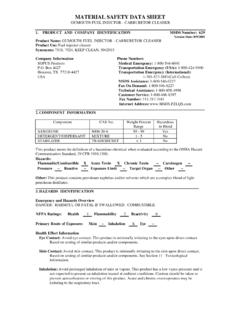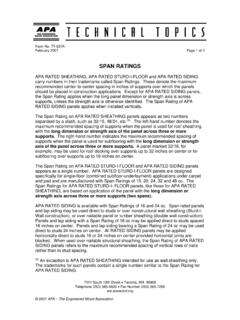Transcription of Material Safety Data Sheet - Schmeling
1 - Continued - 21600/MW Material Safety data Sheet Document Code: 21600/MW Date of Preparation Version: 06 January 30, 2006 Section 1 - Product and Company Identification PRODUCT NAME & NUMBERS HMIS CODES MINWAX High Performance Wood Filler (Part A) Health 2* 21600/41600 Flammability 3 (MSDS for Part B Hardener is also attached) Reactivity 2 MANUFACTURER'S NAME EMERGENCY TELEPHONE NO.
2 MINWAX Company (216) 566-2917 10 Mountainview Road INFORMATION TELEPHONE NO. Upper Saddle River, NJ 07458 (800) 523-9299 Section 2 Composition/Information on Ingredients % WT. CAS No. Ingredient Name Vapor Pressure ---------------------------------------- ------------------------------------ 13 100-42-5 Styrene ACGIH TLV 20 ppm mm ACGIH TLV 40 ppm STEL OSHA PEL 100 ppm OSHA PEL 215 ppm CEILING 24 14807-96-6 Talc ACGIH TLV 2 mg/m3 as Resp.
3 Dust OSHA PEL 2 mg/m3 as Resp. Dust 30 471-34-1 Calcium Carbonate ACGIH TLV 10 mg/m3 as Dust OSHA PEL 15 Total Dust OSHA PEL 5 mg/m3 Respirable Fraction Note: Styrene becomes non-volatile when catalyzed Section 3 Hazards Identification ROUTES OF EXPOSURE INHALATION of vapor or spray mist. EYE or SKIN contact with the product, vapor or spray mist. EFFECTS OF OVEREXPOSURE EYES: Irritation. SKIN: Prolonged or repeated exposure may cause irritation.
4 INHALATION: Irritation of the upper respiratory system. May cause nervous system depression. Extreme overexposure may result in unconsciousness and possibly death. SIGNS AND SYMPTOMS OF OVEREXPOSURE Headache, dizziness, nausea, and loss of coordination are indications of excessive exposure to vapors or spray mists. Redness and itching or burning sensation may indicate eye or excessive skin exposure. MEDICAL CONDITIONS AGGRAVATED BY EXPOSURE None generally recognized. CANCER INFORMATION For complete discussion of toxicology data refer to Section 11. Page 2 of 8 - Continued - 21600/MW Section 4 First Aid Measures EYES: Flush eyes with large amounts of water for 15 minutes.
5 Get medical attention. SKIN: Wash affected area thoroughly with soap and water. Remove contaminated clothing and launder before re-use. INHALATION: If affected, remove from exposure. Restore breathing. Keep warm and quiet. INGESTION: Do not induce vomiting. Get medical attention immediately. Section 5 Fire Fighting Measures FLASH POINT LEL UEL 97 F PMCC FLAMMABILITY CLASSIFICATION RED LABEL -- Flammable, Flash below 100 F EXTINGUISHING MEDIA Carbon Dioxide, Dry Chemical, Foam UNUSUAL FIRE AND EXPLOSION HAZARDS Closed containers may explode when exposed to extreme heat.
6 Application to hot surfaces requires special precautions. During emergency conditions overexposure to decomposition products may cause a health hazard. Symptoms may not be immediately apparent. Obtain medical attention. SPECIAL FIRE FIGHTING PROCEDURES Full protective equipment including self-contained breathing apparatus should be used. Water spray may be ineffective. If water is used, fog nozzles are preferable. Water may be used to cool closed containers to prevent pressure build-up and possible autoignition or explosion when exposed to extreme heat. Section 6 Accidental Release Measures STEPS TO BE TAKEN IN CASE Material IS RELEASED OR SPILLED Remove all sources of ignition.
7 Ventilate the area. Remove with inert absorbent. Section 7 Handling and Storage STORAGE CATEGORY DOL Storage Class IC PRECAUTIONS TO BE TAKEN IN HANDLING AND STORAGE Contents are FLAMMABLE. Keep away from heat, sparks, and open flame. During use and until all vapors are gone: Keep area ventilated - Do not smoke - Extinguish all flames, pilot lights, and heaters - Turn off stoves, electric tools and appliances, and any other sources of ignition. Consult NFPA Code. Use approved Bonding and Grounding procedures. Keep container closed when not in use. Transfer only to approved containers with complete and appropriate labeling. Do not take internally.
8 Keep out of the reach of children. Section 8 Exposure Controls/Personal Protection PRECAUTIONS TO BE TAKEN IN USE Use only with adequate ventilation. Avoid contact with skin and eyes. Avoid breathing vapor and spray mist. Wash hands after using. This product may contain materials classified as nuisance particulates (listed "as Dust" in Section 2) which may be present at hazardous levels only during sanding or abrading of the dried film. If no specific dusts are listed in Section 2, the applicable limits for nuisance dusts are ACGIH TLV 10 (total dust), 3 (respirable fraction), OSHA PEL 15 (total dust), 5 (respirable fraction).
9 Page 3 of 8 - Continued - 21600/MW Section 8 Exposure Controls/Personal Protection (continued) Removal of old paint by sanding, scraping or other means may generate dust or fumes that contain lead. Exposure to lead dust or fumes may cause brain damage or other adverse health effects, especially in children or pregnant women. Controlling exposure to lead or other hazardous substances requires the use of proper protective equipment, such as a properly fitted respirator (NIOSH approved) and proper containment and cleanup. For more information, call the National Lead Information Center at 1-800-424-LEAD(in US) or contact your local health authority.
10 VENTILATION Local exhaust preferable. General exhaust acceptable if the exposure to materials in Section 2 is maintained below applicable exposure limits. Refer to OSHA Standards , , RESPIRATORY PROTECTION If personal exposure cannot be controlled below applicable limits by ventilation, wear a properly fitted organic vapor/particulate respirator approved by NIOSH/MSHA for protection against materials in Section 2. When sanding or abrading the dried film, wear a dust/mist respirator approved by NIOSH/MSHA for dust which may be generated from this product, underlying paint, or the abrasive. PROTECTIVE GLOVES Wear gloves which are recommended by glove supplier for protection against materials in Section 2.


